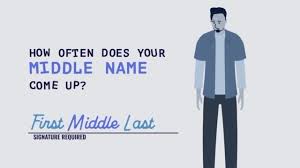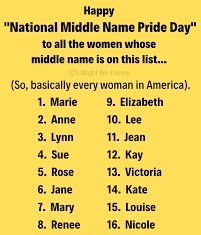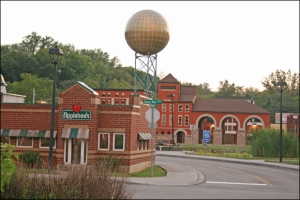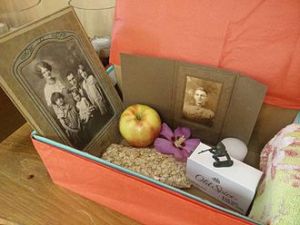Sixteen years after her debut album Some Hearts, Carrie Underwood released a collection of Christian songs called My Savior, a genre for which her signature was long overdue. My Savior was the perfect companion for the drive to and from Easter church last Sunday. On the other hand, Carrie dabbles in hard-driving, anger-cleansing rants like “Last Name”, which is a convenient segue to today’s topic. What (and why) is your middle name?

Think about it for a sec… when was the last time you used your middle name? When you pulled out your driver’s license? Your Social Security card? When you signed an important document? Most likely it was for your last airplane ticket. After all, the name you enter into the reservation has to match the name on the form of identification you provide.
Middle names originated in the Middle Ages (and boy do I love that coincidence). European countries – and much later America – picked up on Italy’s tradition of “double” first names. Since Italian descendants were often named after parents and grandparents, you had a whole lot of Leonardos and Marcos wandering around. “Secondary first” names helped distinguish Leo III from Leo IV. Kind of like George H. W. Bush and George W. Bush.
 I don’t know anyone – and I mean anyone – who uses their middle name by way of introduction, let alone conversation. Outside of family members you might know the middle name of a friend or two but that’s about it. Whatever practical purpose middle names served seems to have come and gone.
I don’t know anyone – and I mean anyone – who uses their middle name by way of introduction, let alone conversation. Outside of family members you might know the middle name of a friend or two but that’s about it. Whatever practical purpose middle names served seems to have come and gone.
Unless you’re me, of course. “David Wilson” is about as common as “John Smith” (and the reason you readers will never be able to hunt me down… bah-ha-ha!) Just how common is my name? Years ago I joined Hertz’s #1 Club and proudly stated my name at the counter for my first rental. The agent tapped away and then said, “Sorry, but we have over 400 David Wilson’s in our database. Could you be more specific?” Then I gave her my middle name (Scott), to which she said, “Okay, so now I still have five of you”. Sigh…

Scott was a common middle name back when I was born. In fact, Scott ranked in the top ten boys’ middle names of the 1960s. (See if your middle name is/was a top tenner here.) Maybe that’s why my parents chose Scott, because I’m not aware of any ancestors with the name. Then again, Ancestry.com tells me I’m 12% Scottish. Hey, my parents could’ve gone with “Scot” instead!
Early in my career, my colleagues and I decided to use our middle names in a desperate attempt to sound cooler. We started referring to each other by first initial and middle name. Hence I was “D. Scott” around the office (which sounds oh-so pompous in hindsight). Didn’t last very long and my signature never changed. I’ve always been a first-name, middle initial, last-name kind of guy with the pen.

Chances are your middle name was given to you because it sounded good alongside your first name. Such was the case with our oldest son Mark. We came up blank with middle names when he was born, so my wife got in touch with a college friend, whose husband was also Mark. Mark Christopher. The middle name sounded great to us so we promptly “adopted” it. Not that our Mark will ever meet his namesake.
Speaking of my wife, her middle name is Marie; the same middle name given to both of her sisters (and later on to our daughter). Marie and Ann are the most popular American female middle names of all time (for the males: Lee, Edward, and Michael). Check those decade lists again – Marie and Ann were tops in 1950 and again for the next forty years. Ann dropped off a little after that but Marie continues to be the most popular to this day.
 Here in the South, a lot of people combine first and middle names. Hence, Sarah is better known as Sarah Beth and Billy is better known as Billy Bob. At least they’re using their middle names. Some of today’s parents are choosing names like “Symphony” and “Rembrandt” to go in the middle. As if their kids will actually use those names someday, right? With that in mind, I’d like to thank my parents for (middle) naming me “Scott”. Sounds just fine to me.
Here in the South, a lot of people combine first and middle names. Hence, Sarah is better known as Sarah Beth and Billy is better known as Billy Bob. At least they’re using their middle names. Some of today’s parents are choosing names like “Symphony” and “Rembrandt” to go in the middle. As if their kids will actually use those names someday, right? With that in mind, I’d like to thank my parents for (middle) naming me “Scott”. Sounds just fine to me.
Some content sourced from The Atlantic article, “Middle Names Reveal More Than You Think”, and the Fox8.com article, “The most common middle names from the last 12 decades”.













































